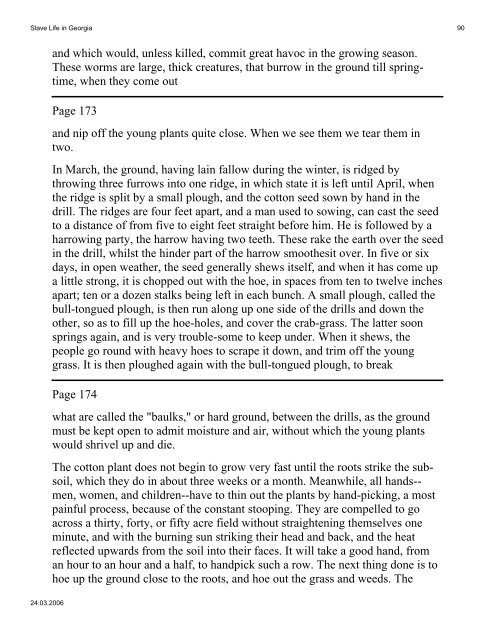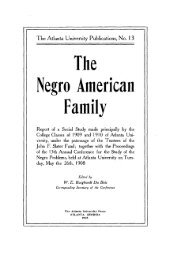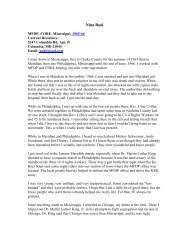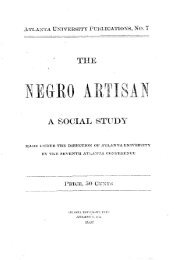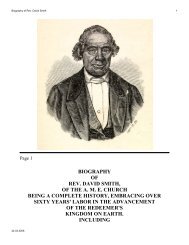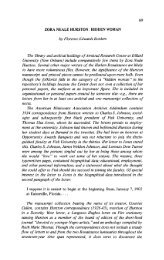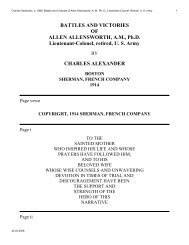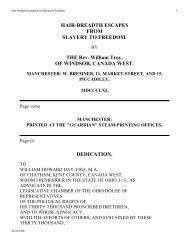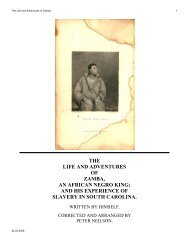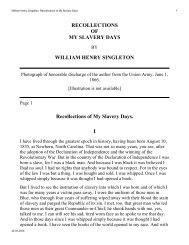Slave Life in Georgia - African American History
Slave Life in Georgia - African American History
Slave Life in Georgia - African American History
You also want an ePaper? Increase the reach of your titles
YUMPU automatically turns print PDFs into web optimized ePapers that Google loves.
<strong>Slave</strong> <strong>Life</strong> <strong>in</strong> <strong>Georgia</strong> 90<br />
and which would, unless killed, commit great havoc <strong>in</strong> the grow<strong>in</strong>g season.<br />
These worms are large, thick creatures, that burrow <strong>in</strong> the ground till spr<strong>in</strong>gtime,<br />
when they come out<br />
Page 173<br />
and nip off the young plants quite close. When we see them we tear them <strong>in</strong><br />
two.<br />
In March, the ground, hav<strong>in</strong>g la<strong>in</strong> fallow dur<strong>in</strong>g the w<strong>in</strong>ter, is ridged by<br />
throw<strong>in</strong>g three furrows <strong>in</strong>to one ridge, <strong>in</strong> which state it is left until April, when<br />
the ridge is split by a small plough, and the cotton seed sown by hand <strong>in</strong> the<br />
drill. The ridges are four feet apart, and a man used to sow<strong>in</strong>g, can cast the seed<br />
to a distance of from five to eight feet straight before him. He is followed by a<br />
harrow<strong>in</strong>g party, the harrow hav<strong>in</strong>g two teeth. These rake the earth over the seed<br />
<strong>in</strong> the drill, whilst the h<strong>in</strong>der part of the harrow smoothesit over. In five or six<br />
days, <strong>in</strong> open weather, the seed generally shews itself, and when it has come up<br />
a little strong, it is chopped out with the hoe, <strong>in</strong> spaces from ten to twelve <strong>in</strong>ches<br />
apart; ten or a dozen stalks be<strong>in</strong>g left <strong>in</strong> each bunch. A small plough, called the<br />
bull-tongued plough, is then run along up one side of the drills and down the<br />
other, so as to fill up the hoe-holes, and cover the crab-grass. The latter soon<br />
spr<strong>in</strong>gs aga<strong>in</strong>, and is very trouble-some to keep under. When it shews, the<br />
people go round with heavy hoes to scrape it down, and trim off the young<br />
grass. It is then ploughed aga<strong>in</strong> with the bull-tongued plough, to break<br />
Page 174<br />
what are called the "baulks," or hard ground, between the drills, as the ground<br />
must be kept open to admit moisture and air, without which the young plants<br />
would shrivel up and die.<br />
The cotton plant does not beg<strong>in</strong> to grow very fast until the roots strike the subsoil,<br />
which they do <strong>in</strong> about three weeks or a month. Meanwhile, all hands--<br />
men, women, and children--have to th<strong>in</strong> out the plants by hand-pick<strong>in</strong>g, a most<br />
pa<strong>in</strong>ful process, because of the constant stoop<strong>in</strong>g. They are compelled to go<br />
across a thirty, forty, or fifty acre field without straighten<strong>in</strong>g themselves one<br />
m<strong>in</strong>ute, and with the burn<strong>in</strong>g sun strik<strong>in</strong>g their head and back, and the heat<br />
reflected upwards from the soil <strong>in</strong>to their faces. It will take a good hand, from<br />
an hour to an hour and a half, to handpick such a row. The next th<strong>in</strong>g done is to<br />
hoe up the ground close to the roots, and hoe out the grass and weeds. The<br />
24.03.2006


